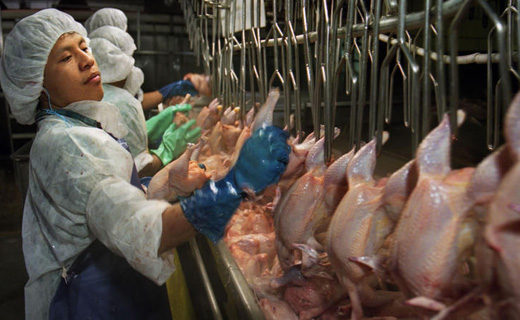
MINNEAPOLIS – Poultry workers in the United States suffer high rates of injury, earn poverty level wages and work in a climate of fear, according to a new report by Oxfam America, produced in association with a Minnesota-based worker center and other groups.
Oxfam said the report, “Lives on the Line,” is the first step in a campaign to rally consumers to call on the nation’s largest poultry companies to treat workers with fairness and dignity.
“There’s always a lot of concern about the treatment of the animals, but we want to focus the public’s attention on how the workers are treated,” said Dale Moerke, co-chair of the Greater Minnesota Worker Center, a St. Cloud-based organization that assisted with the report.
The 48-page document includes interviews with workers, analysis of workplace injury data and summaries of numerous studies done on conditions facing poultry industry workers. The focus is on Tyson Foods, Pilgrim’s Pride, Perdue, and Sanderson Farms – four companies that control 60 percent of the U.S. poultry market.
The report also attracted attention at the federal Occupational Safety and Health Administration. Barely a week after Oxfam released it, OSHA announced a one-year program of “education, outreach and targeted enforcement” in the eight Southern states with the most poultry processing plants.
Its program will concentrate on probing ergonomic (repetitive-motion) and musculoskeletal injuries to the tens of thousands of workers in the plants in Alabama, Arkansas, Florida, Georgia, Louisiana, Mississippi, Oklahoma and Texas.
After three months of warnings and education, which began Oct. 26, the agency will step up on-site inspections and “a review of poultry processing production operations, working conditions, recordkeeping, chemical handling and safety and health programs to ensure compliance.” It also will keep an eye out for company retaliation against whistleblowers, and warned that its program could last beyond next October.
The companies In Oxfam’s report do not have Minnesota production plants, but workers at GNP Companies (Gold’n Plump) and Jennie-O facilities in Cold Spring, Faribault, Luverne, Montevideo and Willmar face problems similar to those outlined in the report, said Bernie Hesse, director of special projects, legislative and political action for United Food and Commercial Workers Local 1189 in South St. Paul. UFCW represents poultry plant workers nationwide.
“It doesn’t matter what state it is in, line speeds are incredibly fast, because we’ve really stepped up mechanization of the industry,” Hesse said.
The report cites dozens of medical and government studies that document how the relentless pace of the processing line and more than 20,000 cutting, pulling, and hanging motions per worker per day contribute to painful and crippling musculoskeletal injuries. Poultry workers suffer carpal tunnel syndrome seven times more often than workers in all other industries; they suffer occupational illnesses at five times the rate.
Workers interviewed for the report described how injuries were ignored and untreated by management. They also said they were threatened for speaking out.
“I used to tell them that I needed to see a specialist, but they refused me,” said Pedro, a former worker at a Tyson plant in North Carolina. “And I asked… can I go down to see my own orthopedist? And they said, ‘If you do that, we’re going to fire you.'”
The pace of the processing line is so relentless – and workers get so few breaks – that they describe soiling themselves because there was no opportunity to use the bathroom.
The pace may get worse: The union that represents U.S. poultry inspectors, the American Federation of Government Employees, has been fighting Agriculture Department rules – pushed by the poultry processing plant owners – to speed up the lines and to let plant managers, not poultry inspectors, examine chicken and turkey carcasses.
Most of the roughly 250,000 poultry workers in the United States are people of color, immigrants, and refugees, and a significant number are women. Many of the workers are afraid to speak out for fear of losing the only job available to them in their community.
“Without an immigrant workforce, this industry wouldn’t be able to process and put product out,” noted Hesse. Most poultry processing workers aren’t represented by unions and organizing is difficult because of the high turnover caused, in part, by the hazardous nature of the work and the low pay.
Health and safety experts, speaking with reporters in a conference call, said the industry is not doing enough to address dangerous working conditions.
Many of the industry’s claims of safety are based on self-reporting and undercount the true number of injuries, said Dr. Celeste Monforton, a professorial lecturer in environmental and occupational health at George Washington University and former analyst for OSHA.
“Employers have gone to great lengths to avoid responsibility for these injuries,” Monforton said.
Responding to the report on behalf of the poultry industry, the National Chicken Council issued a statement that said, in part, “It is unfortunate that Oxfam portrays an undeserved negative image of the entire poultry industry despite our outstanding record of improvement in employee health and safety, particularly over the past three decades.”
Oxfam America’s report offers detailed recommendations for companies to change the way the industry treats its workers, including:
- Healthy and safe workplace: Provide a healthy and safe environment in plants, which includes reasonable line speeds, adequate staffing to allow for rest and bathroom breaks, and proper medical care for injured workers.
- Worker voice and empowerment: Allow workers to have a greater voice in the workplace, ensure they understand their rights, and provide an atmosphere of tolerance to act on those rights.
- Fair compensation: Pay workers a fair wage that enables them to support their families without relying on federal assistance or charity. Provide paid time off, especially earned sick time.
In addition to issuing the report, the campaign includes a detailed website on conditions facing poultry industry workers.
Next steps include putting more pressure on OSHA to increase inspections, said Moerke. OSHA’s announcement, after the report, shows it is preparing to do so.
To gather more information for the campaign, the Greater Minnesota Worker Center is conducting detailed surveys of poultry plant workers. “We have to get the communities involved and make them understand what is going on in the workplace,” Moerke said. “That’s crucial.”
The UFCW, which also is partnering in the Oxfam campaign, believes there is a connection between food safety, humane treatment of animals and safety and dignity for workers, said Hesse.
“There’s a cost for our food that I don’t think is recognized…We’ve gotten along quite well for a long time on cheap food that doesn’t reflect the cost that workers put into it.”
Barb Kucera is Editor, Workday Minnesota (see link below)
Photo: A female worker hangs chicken at a poultry processing plant. | Workday Minnesota











